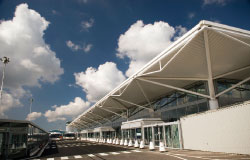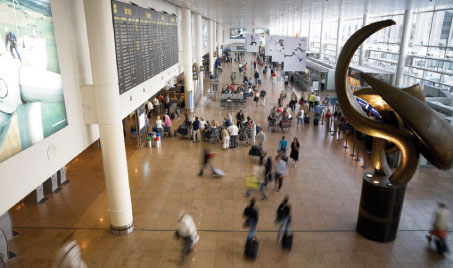
At all of Macquarie’s main airports, charges are set following negotiations with airlines.
As well as its stake in four key airports, Macquarie Capital Funds has interests worldwide, including Newcastle in the UK, Australia’s Hobart airport, Japan Airport Terminal (Haneda Airport) and ASUR in Mexico.
Macquarie’s international experience has been based on addressing the needs of all stakeholders, including airlines, passengers and investors, said Sharp. “All our core airports have performed well and our investment criteria has stood us in good stead. We seek to buy airports with strong catchment areas, commercial opportunities, transparent regulation, high quality facilities and some spare capacity,” he said.
Prudent decision-making has enabled Macquarie Capital Funds to invest in airports already well placed to sustain the interests of the low-cost and traditional carriers. “With the management capability we bring to the airports, and the strength of their own management teams, this has led to excellent results,” said Sharp.
Macquarie’s successes are apparent across the entire spectrum of airport operations, including increased traffic flow, enhanced passenger processing and facilitation in the terminal, lower overall passenger costs, more efficient capital expenditure and improved commercial offerings. Macquarie is well aware of the need to address wider issues. “In the long run, our success depends on developing our airports to achieve their full potential. This requires each of our airports finding ways to meet the needs of all of our stakeholders including passengers, airlines, the community around the airport, local and national governments and the wider region in which the airport is situated,” said Sharp.

Just over 167 million passengers pass through the airports that Macquarie has stakes in (2007 statistics).
CHARGING POLICY
Against this background, setting appropriate aeronautical charges is a complex and delicate process, depending on the current pressures of the market in which the airport operates, the facilities and costs of the facilities airlines use and the requirements and preferences of airline customers, explained Sharp. Other factors, such as noise or other environmental impacts may also be relevant.
Currently, charges at Brussels and Copenhagen follow the conventional model and are weight-based for runway use, passenger-based for terminal and security charges and time and weight based for airport parking. However, in Brussels the runway charge is moderated by noise and time of day, with the levy increasing at night. In contrast to these relatively conventional systems, Sydney’s international flights are primarily funded through a single per passenger charge.
At all of Macquarie’s main airports, charges are set following negotiations with airlines. Both Sydney and Bristol are not price controlled and agreements are reached with individual airlines. Negotiated caps on charges have also been agreed with airlines at Brussels and Copenhagen, although these remain subject to regulatory action if required to resolve intractable disagreements.
The charging policy at an airport is influenced by the specific objectives of airports, airlines, regulators and regional and national governments. Investment programmes are an important issue. “Inevitably airlines have different preferences and requirements and there will be a degree of tension between airlines themselves regarding the investments needed at an airport, the order in which they should be done, and how they should be paid for.
Airports may also have to take into account the needs of future carriers and those of the wider community,” said Sharp.
Macquarie airport teams work to address these conflicting needs, although the ideal would be an airport pricing system that adequately reflects both the costs that different airlines impose on an airport – through the efficiency with which they use facilities and the competitive position which the airport faces.
BUDGET AIRLINES
One aspect of the low-cost revolution is the focus placed on airports to perform in terms of costs and prices.
“Low-cost airlines have made it very clear to airports that they are competing for services and that price is a key component of that competition. Low-cost airlines, in particular, are highly focused in their concentration on placing their aircraft where they make most money,” said Sharp. “A new service from Bristol to Madrid, for example, may well be in competition across Europe with Budapest to Rome, or Stockholm to Berlin. Airlines like Ryanair and easyJet will emphasise the power that they believe such a situation gives them.” The low-cost carrier business model inevitably results in pressure for lower charges, he added. “A low-cost carrier can operate through simpler facilities using short turn-around times, with high load factors and outside peak periods. They are likely to impose lower costs on the airport than other carriers and as a result could reasonably qualify for lower charges.”
The Macquarie airports team has been a very effective operator in bringing in the budget airlines. Given the lack of growth in other segments of the market, it is seen as a priority for Macquarie’s long-term success. However, competition to attract low-cost carriers between airports is fierce, explained Sharp. “As far as airlines are concerned, we need to deliver facilities in which they can operate efficiently, are attractive to passengers and at prices which are fully competitive.
Low-cost airlines are very good at letting us know if we don’t succeed on any of these criteria, and we know they will only continue to operate at our airports if we deliver what they want.”

Sharp: “It’s now become more important for airports and airlines to reach agreements to work together effectively.”
RESOLVING CONFLICT
Achieving agreement with all parties within an airport’s regulatory environment is a challenge for any operator.
Despite the best efforts of regulators, reaching agreement can sometimes be easier in the absence of a regulatory backstop. The prospect of intervention can encourage parties to adopt fixed positions and employ public pressure to strengthen their ground in a potential arbitration, rather than make the negotiated compromises needed to reach a solution which will work for all parties, Sharp explained. “Nevertheless, we support approaches where the parties determine the way in which they are going to work together between themselves, rather than relying on third parties, and as a result, do whatever we can to encourage and assist our airports in making systems based on direct discussions work effectively. Regulation at airports such as Brussels and Copenhagen is designed to support, rather than replace commercial discussions, and it is in our interest to respond to that,” he said. “In practice there needs to be a degree of commercial give-and-take as the airport tries to find solutions which meet everyone’s needs. But one crucial issue remaining is the discipline of the market.
Ultimately an airport should only construct facilities which users are prepared to pay for.”Recognising the challenges posed to airports and airlines in the current global economic market, Sharp emphasised the importance of collaboration in the industry. “It’s now become more important for them to reach agreements to work together effectively.”
To be effective in attracting new carriers, price is not the only important issue, he added. Macquarie is continuing to promote marketing strategies, market and route research, as well as working with local and national tourism and business agencies, in the region in which the airport is situated. “In the long run, however, airlines will only viably operate new services where they believe they will cover their costs and be profitable. This will naturally include an assessment of the impact of aeronautical charges,” said Sharp.







